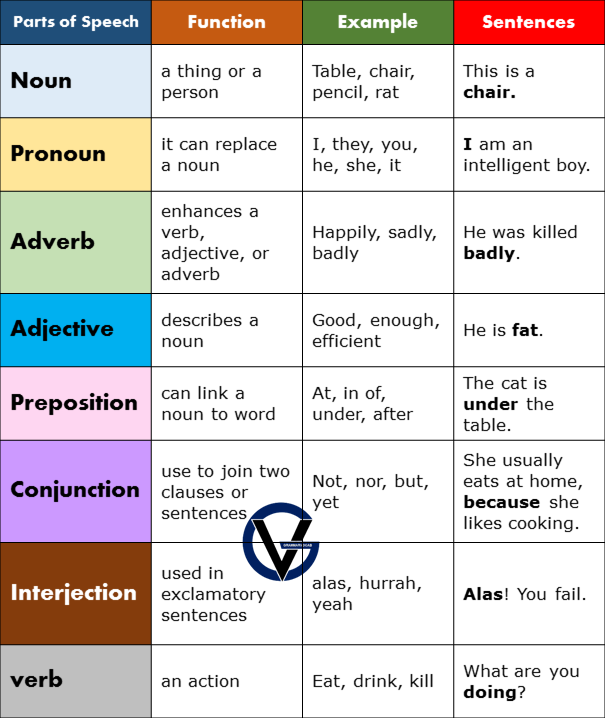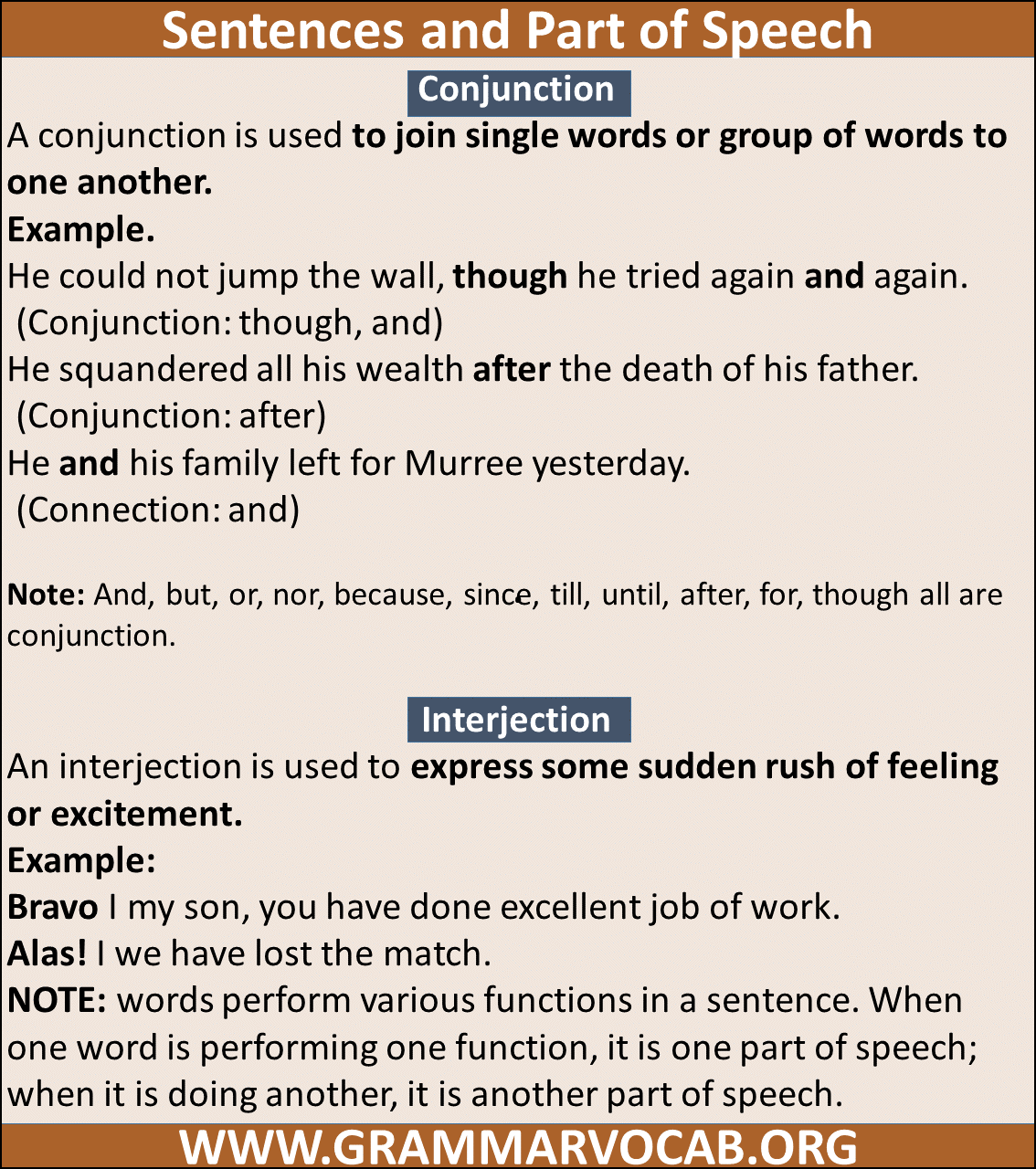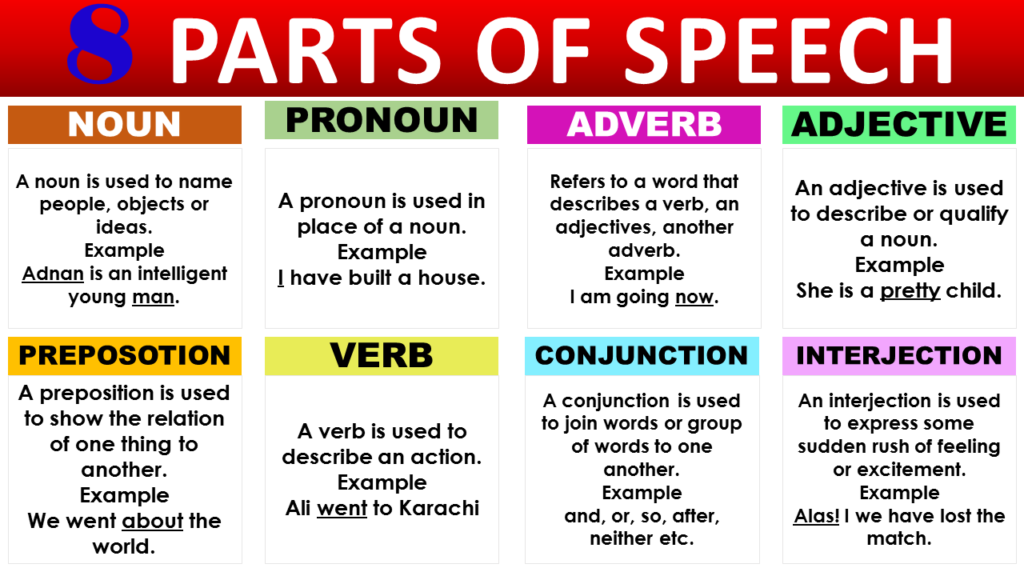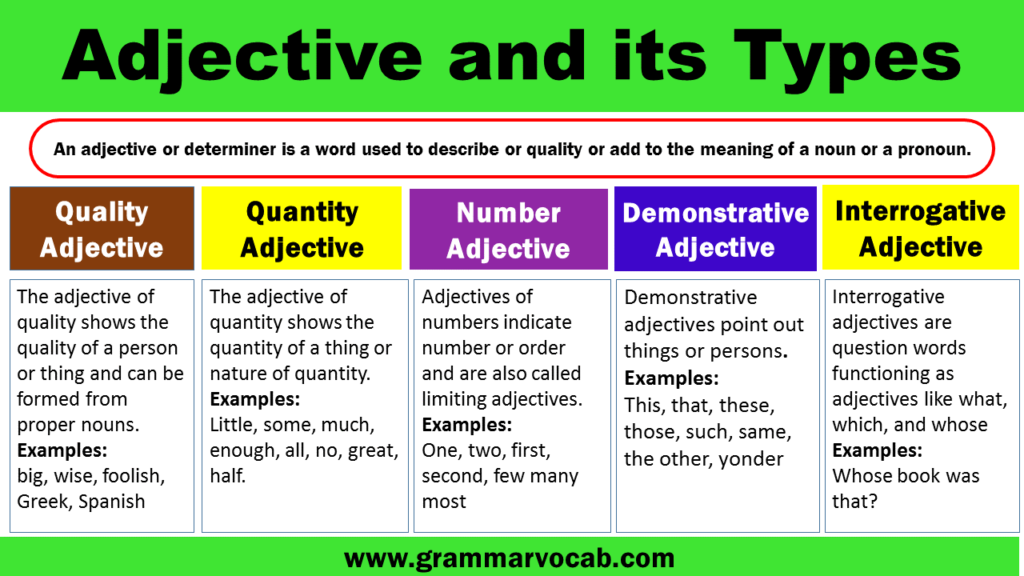PARTS OF SPEECH IN ENGLISH!
Definition of Parts of Speech
Every word used in a sentence occupied a position and fulfills a function. The words in a sentence are, therefore, divided into causes, called parts of speech, according to the function they fulfill. Parts of speech play an important role in sentence structure.
Parts of Speech in English Table Infographic

This article will explain to you 8 parts of speech and how to use them in sentences.
There are eight parts of speech.
NOUN
A noun is used to name people, places, objects, or ideas.
Examples:
- Adnan is an intelligent young
- Paris is the capital of
- Honesty is the best
- The doctor saved the life of the
- The dog barked loudly at the mailman.
- I need to buy some groceries for dinner tonight.
- My favorite book is “To Kill a Mockingbird.”
- The sun was shining brightly in the sky.
- She wore a beautiful dress to the party.
- The ocean is so vast and mysterious.
- The teacher gave us a lot of homework to do.
- The movie we saw last night was really good.
- The coffee at this café is always delicious.
- The tree in my backyard is starting to bloom.
PRONOUN
A pronoun is used in place of a noun.
Example:
- I have built a house.
- He gave me a nice gift.
- It is her sixteenth birthday.
- She gave the book to him.
- They went to the park with their
- He likes to play basketball, but she prefers soccer.
- I am not sure what they are talking about.
- The dog wagged its tail excitedly.
- He was proud of his
- She is going to meet her boss for lunch.
- They decided to go on vacation by themselves.
- We are happy to help with your
ADJECTIVE
An adjective is used to describe or qualify a noun.
Examples:
- I have written two chapters of this
- She is a pretty
- It is a tall
- Muhammad Ali was the greatest
- The tall man walked into the room and greeted us warmly.
- The delicious aroma of freshly baked bread filled the kitchen.
- I felt nervous as I stepped onto the stage to give my speech.
- The happy couple danced the night away at their wedding reception.
- The fierce wind tore through the trees, causing leaves to scatter in all directions.
- Her bright smile lit up the room and made everyone feel welcome.
- The adorable puppy wagged its tail and jumped up to greet its new owner.
- The peaceful sound of waves crashing on the shore helped me relax and unwind.
- The spicy curry was too hot for me to handle, but my friend loved it.
VERB
A verb is used to describe an action.
Examples:
- Ali went to Karachi
- He goes to the office every day.
- She will not tell a lie.
- I have done my duty.
- The cat slept on the windowsill.
- The children played in the park.
- She baked a delicious cake for the party.
- He ran the marathon in under three hours.
- The students studied for their exams all night.
- The bird sang a beautiful melody.
- The company announced a new product line.
- The dog barked at the mailman.
- She painted a colorful picture on the canvas.
ADVERB
An adverb is used to qualify a verb by telling us how, why, when, or where the actions take place. It is also used to add to the meaning of an adjective, adverb, a preposition, or conjunction.
Example:
He was walking quickly.
I am going now.
He is a brilliant young lady.
He singled the moment he saw the car.
The concert was held at the Bukhari Auditorium.
He ran very fast.
Note: There are three kinds of adverbs.
- Adverbs of Manner
- Adverb of Place
- Adverb of Time
In a sentence, they are normally used in the order given above.
Note: When a sentence has a verb of movement, the adverb of place comes immediately after the verb. Example: He went to Hawaii by Air yesterday.
Preposition
A preposition is used to show the relation of one thing to another. It is a word placed before a noun or a pronoun to show in what relation the person or thing denoted by it stands in relation to something else.
Example:
- We went about the world.
- We take tea in the afternoon.
- She sent the parcel by post.
- The Eaglets won with ease.
- It is a book of great value.
- For one enemy he has a hundred friends.
- From what I know of him, I hesitate to trust him.
- She is sitting at the desk.
- The book is on the table.
- I walked through the park.
- He ran into the room.
- They are going to the beach.
- The cat is hiding under the bed.
- She is standing beside the car.
- The plane is flying over the city.
- We went with our friends to the party.
- He is speaking about his trip.
Conjunction
A conjunction is used to join single words or groups of words to one another.
Example.
He could not jump the wall, though he tried again and again.
(Conjunction: though, and)
He squandered all his wealth after the death of his father.
(Conjunction: after)
He and his family left for Murree yesterday.
(Connection: and)
Note: And, but, or, nor, because, since, till, until, after, for, though all are conjunction.
Interjection
An interjection is used to express some sudden rush of feeling or excitement.
Example:
- Bravo my son, you have done an excellent job of work.
- Alas! we have lost the match.
- Wow, that sunset is beautiful!
- Ouch, that really hurt my foot!
- Oh no, I left my phone at home.
- Ah, I finally understand how to solve this math problem.
- Hey, can you pass me the salt please?
- Ugh, I can’t believe I have to work late again tonight.
- Yikes, that was a close call!
- Hooray, we won the game!
NOTE: words perform various functions in a sentence. When one word is performing one function, it is one part of speech; when it is doing another, it is another part of speech.
Parts of Speech in English Table
|
Parts of Speech |
Function | Example |
Sentences |
| Noun | a thing or a person | Table, chair, pencil, rat | This is a chair. |
| Pronoun | it can replace a noun | I, they, you, he, she, it | I am an intelligent boy. |
| Adverb | enhances a verb, adjective, or adverb | Happily, sadly, badly | He was killed badly. |
| Adjective | describes a noun | Good, enough, efficient | He is fat. |
| Preposition | can link a noun to word | At, in of, under, after | The cat is under the table. |
| Conjunction | use to join two clauses or sentences | Not, nor, but, yet | She usually eats at home, because she likes cooking. |
| Interjection | used in exclamatory sentences | alas, hurrah, yeah | Alas! You fail. |
| verb | an action | Eat, drink, kill | What are you doing? |
Parts of Speech Video Lesson
Parts of speech in English Infographics



parts of speech in English Pdf



